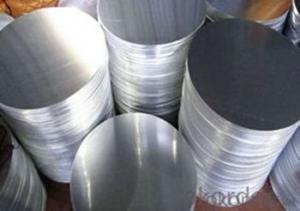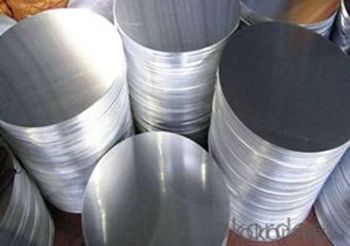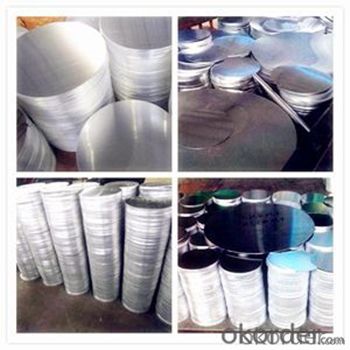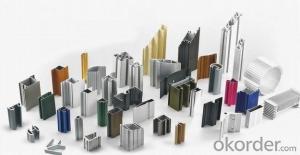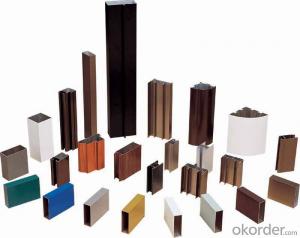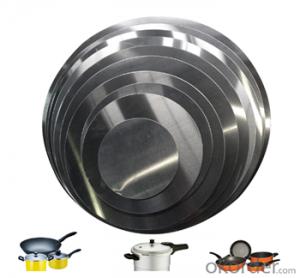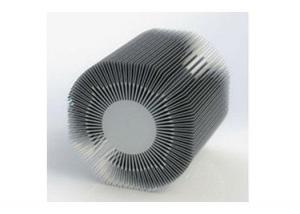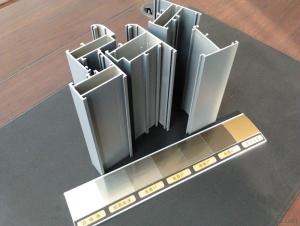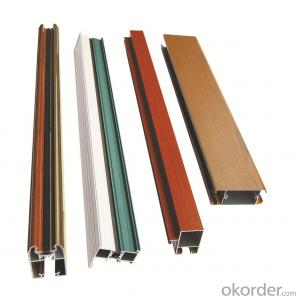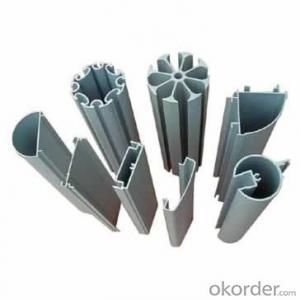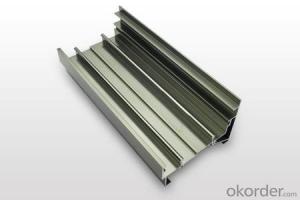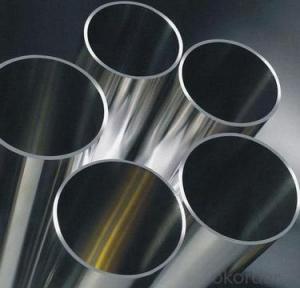High Quality Aluminum Structural Building Profiles with Good Price
- Loading Port:
- Qingdao
- Payment Terms:
- TT OR LC
- Min Order Qty:
- 10000 kg
- Supply Capability:
- 100000 kg/month
OKorder Service Pledge
OKorder Financial Service
You Might Also Like
Specification
Aluminum Discs
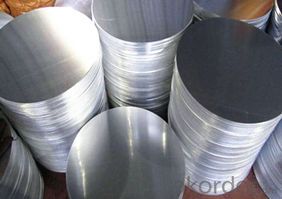
Aluminum Discs introduction
Our company to introduce advanced aluminum discs production equipment, effectively improve production efficiency and material utilization, shorten the delivery cycle. Our company strengthened the control of the grain size and elongation of the coil, Respectively cold rolled and hot rolled aluminum discs was launched,and cover 1, 3, 5, 8 series alloys. Complete product range, thickness 0.7-6.0 mm, diameter 100-1200 mm, tolerance in line with national standard requirements.
Aluminum Discs Features
1.Aluminum discs specifications complete,conventional size outside,can provide the most thin 0.5 mm, the most thick 6.5 mm aluminum discs;
2.Aluminum discs surface performance is good, to ensure no obvious scratches, oil, oxidation, dark spots and so on;
3.Aluminum discs thickness> 1.0 mm, to ensure that the finished side of the neat no burrs;
4.The good control of grain size and elongation in early stage,to ensure that the aluminum discs of the deep drawing and spinning performance, effectively avoid the late processing may occur when the drawing, lotus leaf, the ear rate of high bad phenomenon;
5.Strictly control the coil of the alloy, the state, performance, to ensure the accuracy and diversity of aluminum discs provided;
6.The introduction of advanced and efficient production equipment, improve the production efficiency of aluminum discs and the utilization rate of material and shorten the production cycle, provide real-time and convenient service for the customer;
7.Aluminum discs detailed classification, according to different purposes and requirements, customers can choose accurate category;
8.Products comply with RoHS and REACH the environmental protection standard;
9.Product packaging firm, in line with domestic sales and international export standards.
Introduction of our company
Our company is a professional Aluminium Strip manufacturer and Aluminum Circles manufacturers,mainly supply Aluminium Coil,Aluminum Circles,Aluminium discs,Aluminum Sheet,Aluminum Strip, Household Aluminum Foil,Aluminum Foil for Pharmaceutical Packaging,Aluminum Foil Tape,Aluminum Foil for Air Conditioner,Aluminum Foil for Container etc. series of aluminum products, sincerely welcome everyone to visit.
- Q: Aluminum surface treatment products we have color (pure black and beige wood etc.), the surface coating by scratching the surface, color and color difference of aluminum (aluminum color, the background is simple) after repair or there will be a difference at present, technical staff provides a profile of color, it can paint pen profile the scratch (paint pen according to the material surface spray paint, please fill out this factory can scratch the gap! It's really hard to findConsult an expert who specializes in aluminum processing. What's the effective remedy for scratching after spraying? Are there any professional manufacturers of this kind of paint pen?
- Please fill out paint pen manufacturers can scratch the gap, is the best way, the color of the paint can't find the same, have a great relationship with the concentration ratio, so, when buying sheet with requirements of factory repair paint pen!
- Q: What are the different packaging options for aluminum profiles?
- There are several packaging options available for aluminum profiles, depending on the specific requirements and preferences of the customers. Some of the common packaging options include: 1. Bundles: Aluminum profiles can be packed in bundles, where several profiles of the same length and shape are bundled together using straps or bands. This packaging option is ideal for smaller profiles and offers easy handling and transportation. 2. Wooden crates: For larger or more fragile aluminum profiles, wooden crates are often used. The profiles are securely placed inside the crate and then nailed or screwed shut. Wooden crates provide excellent protection during shipping and can be customized to fit the specific dimensions of the profiles. 3. Cardboard tubes: Thin and lightweight aluminum profiles, such as those used in the packaging industry, can be packaged in cardboard tubes. These tubes provide a cost-effective and lightweight solution for transportation and storage, while still offering adequate protection. 4. Pallets: When dealing with a large volume of aluminum profiles, pallets are often used for packaging. Profiles are stacked and secured on a pallet using strapping or shrink wrap. This packaging option allows for efficient handling, as pallets can be easily loaded and unloaded using forklifts or pallet jacks. 5. Custom packaging: Customers may have unique packaging requirements based on their specific needs. In such cases, custom packaging options can be developed, such as foam inserts, plastic wraps, or specific labeling. Custom packaging ensures that the profiles are adequately protected and that any specific handling instructions are followed. In summary, the packaging options for aluminum profiles can vary depending on factors like profile size, fragility, and volume. Whether it's bundling, wooden crates, cardboard tubes, pallets, or custom packaging, each option offers its own benefits in terms of protection, handling, and ease of transportation.
- Q: Can aluminum profiles be used in the production of audiovisual equipment?
- Aluminum profiles have the capability to be utilized in the manufacturing process of audiovisual equipment. Aluminum, a versatile material widely employed in various industries, including the audiovisual sector, can be employed in constructing frameworks, enclosures, and mounting systems for audiovisual equipment like speakers, projectors, and television screens. The lightweight characteristic of aluminum facilitates easy handling and transportation, while its high strength-to-weight ratio ensures lasting durability and stability. Furthermore, aluminum boasts corrosion resistance, a crucial attribute for equipment that may be exposed to moisture or humidity. Aluminum profiles can also be easily tailored and fabricated to satisfy specific design requirements, providing flexibility in audiovisual equipment production. In summary, the utilization of aluminum profiles in audiovisual equipment production presents numerous benefits in terms of strength, weight, corrosion resistance, and design possibilities.
- Q: What are the possible alternatives to aluminum extrusions in the construction industry?
- <p>Yes, there are several alternative materials that can replace aluminum extrusions in construction projects. These include steel, which is strong and durable but heavier; fiberglass, known for its lightweight and corrosion resistance; and thermoplastics like PVC, which are cost-effective and easy to work with. Each material has its own advantages and limitations, and the choice depends on the specific requirements of the project, such as strength, weight, cost, and environmental factors.</p>
- Q: Can aluminum profiles be used for solar panel mounting systems?
- Yes, aluminum profiles can be used for solar panel mounting systems. Aluminum is a popular choice for solar panel mounting systems due to its numerous advantages. Firstly, aluminum is lightweight, making it easier to handle and install. This is especially important when considering the weight that solar panels can add to a structure. Secondly, aluminum is corrosion-resistant, which is crucial as solar panel mounting systems are exposed to various weather conditions. Additionally, aluminum is a durable material that can withstand high winds, snow loads, and other environmental factors. Furthermore, aluminum profiles can be easily customized and fabricated to fit specific project requirements. They are available in various sizes and shapes, allowing for flexibility in design and installation. Overall, aluminum profiles provide a reliable and efficient solution for solar panel mounting systems.
- Q: What are the regulations and standards that govern the use of aluminum profiles in construction?
- <p>Yes, there are several regulations and standards related to the use of aluminum profiles in construction. These include international standards such as ISO 7039 for anodized aluminum and ISO 9001 for quality management systems. Additionally, regional standards like the European EN 755 for extruded aluminum alloys and the American Architectural Manufacturers Association (AAMA) standards for aluminum products in buildings are crucial. Compliance with these standards ensures the safety, durability, and performance of aluminum profiles in construction applications.</p>
- Q: How do you prevent galvanic corrosion in marine environments with aluminum profiles?
- One way to prevent galvanic corrosion in marine environments with aluminum profiles is by using sacrificial anodes made of a different, more active metal. These anodes, typically made of zinc or magnesium, are connected to the aluminum profiles and act as a sacrificial material that corrodes instead of the aluminum. This helps in protecting the aluminum profiles from galvanic corrosion. Additionally, proper insulation and coating of the aluminum profiles can also be effective in preventing direct contact with other metals and reducing the risk of galvanic corrosion.
- Q: What are the different machining options available for aluminum profiles?
- There are several machining options available for aluminum profiles, depending on the desired outcome and the specific requirements of the project. 1. Milling: Milling is a widely used technique for cutting and shaping aluminum profiles. It involves removing material from the workpiece using a rotating cutter. This process can create complex shapes and features such as slots, pockets, and contours. 2. Drilling: Drilling is a machining process that involves creating holes in the aluminum profiles. It is commonly used to attach components or to provide openings for various purposes. Drilling can be done manually or using CNC machines for precision and efficiency. 3. Turning: Turning is a machining process where a single-point cutting tool is used to remove material from a rotating workpiece. This technique is often used for cylindrical or symmetrical aluminum profiles to create features like threads, grooves, and chamfers. 4. Bending: Bending is a process that is used to reshape aluminum profiles by applying force to bend them into the desired shape. It is commonly used for creating curved or angled profiles for architectural or structural purposes. 5. Punching: Punching is a process that involves using a punch and die set to create holes or cutouts in the aluminum profiles. It is commonly used for creating openings for fasteners, connectors, or other components. 6. Sawing: Sawing is a machining process where a rotating blade is used to cut through the aluminum profile. It is commonly used for cutting aluminum profiles to specific lengths or for separating them into smaller sections. 7. Grinding: Grinding is a machining process that involves using an abrasive wheel to remove material from the aluminum profiles. It is commonly used for surface finishing, deburring, or to achieve tight tolerances on the profile's dimensions. Each machining option has its advantages and limitations, and the choice depends on factors such as the complexity of the desired shape, the required precision, and the material properties of the aluminum profiles. Careful consideration of these factors will help determine the most suitable machining option for a particular project.
- Q: Are aluminum profiles suitable for decorative applications?
- <p>Yes, aluminum profiles are commonly used for decorative purposes. They offer a sleek, modern look and are lightweight, durable, and resistant to corrosion. They can be anodized or powder coated in various colors to match different design aesthetics. Aluminum profiles are versatile and can be used in architectural features, furniture, and various other decorative elements.</p>
- Q: How do you calculate the strength of aluminum profiles?
- To calculate the strength of aluminum profiles, various factors need to be considered. First, the material properties of the aluminum, such as its yield strength and ultimate tensile strength, must be known. Then, the geometric characteristics of the profile, such as its cross-sectional area and moment of inertia, are used in relevant equations to determine the bending, shear, and axial strength of the profile. Additionally, factors like the loading conditions, support conditions, and safety factors are taken into account to ensure the calculated strength is reliable and safe.
Send your message to us
High Quality Aluminum Structural Building Profiles with Good Price
- Loading Port:
- Qingdao
- Payment Terms:
- TT OR LC
- Min Order Qty:
- 10000 kg
- Supply Capability:
- 100000 kg/month
OKorder Service Pledge
OKorder Financial Service
Similar products
Hot products
Hot Searches
Related keywords
